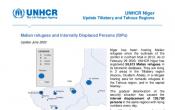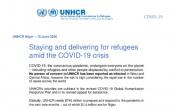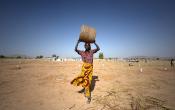Niger
Operation: Niger
Location
{"longitude":8,"latitude":18,"zoom_level":0,"iso_codes":"'NER'"}
By clicking on the icons on the map, additional information is displayed.
The boundaries and names shown and the designations used on this map do not imply official endorsement or acceptance by the United Nations.
Key Figures
| 2019 year-end results | |
| 35,000 | Nigerian refugees were biometrically registered in the Maradi region in November 2019 |
| 1,400 | refugees and asylum-seekers (mostly from Sudan) were accommodated at the humanitarian centre near Agadez |
| 3,100 | people had been evacuated to Niger through the ETM by end 2019 (over 800 in 2019 alone), of whom over 2,300 had been resettled to third countries (almost 1,250 in 2019) |
| 600 | latrines were constructed in Nguigmi and 500 latrines in Diffa |
| 2020 planning figures | |
| 100% | of people of concern registered on an individual basis |
| 100% | of people of concern identified in need of resettlement submitted for resettlement under the Emergency Transit Mechanism |
| 7,000 | Malian and Nigerian refugee households receiving land allocations for shelter |
| 4,000 | Malian and Nigerian refugee households will receive long-term/permanent shelter |
Latest Updates and Related Links
People of Concern
14%
Increase in
2019
2019
| 2019 | 441,899 |
| 2018 | 386,978 |
| 2017 | 315,723 |

[["Refugees",180006],["Asylum-seekers",37919],["IDPs",191902],["Others of concern",32072]]
Loading ...
Niger
< Back
2019
{"categories":[2015,2016,2017,2018,2019,2020],"budget":[49.767155435,51.18816609,82.54923246999999,92.78381448,84.17541579,100.71709432],"expenditure":[27.8804749,25.34641563,36.29079634000001,52.53936455,66.3639569,null]}
{"categories":[2015,2016,2017,2018,2019,2020],"p1":[46.858700085,46.543938270000005,73.06699146,79.23937398000001,68.95205079,71.18714001000001],"p2":[0.25436852,0.9442278199999999,0.685411,0.73349771,0.91654101,0.967348],"p3":[null,null,null,null,null,null],"p4":[2.6540868300000002,3.7,8.796830009999999,12.810942789999999,14.30682399,28.56260631]}
{"categories":[2015,2016,2017,2018,2019,2020],"p1":[25.69854914,20.99749897,28.969805100000002,47.77936734,57.46053413,null],"p2":[0.25079906,0.72452801,0.34086540000000004,0.26129652999999997,0.54782624,null],"p3":[null,null,null,null,null,null],"p4":[1.9311266999999999,3.6243886499999998,6.9801258399999995,4.49870068,8.35559653,null]}
Loading ...
CHOOSE A YEAR
- 2014
- 2015
- 2016
- 2017
- 2018
- 2019
- 2020
Operational context
Niger continued to offer stability and an open asylum space for asylum-seekers and refugees fleeing the various conflict zones in the region - particularly in Libya, Mali and Nigeria. During 2019 it also continued to host migrants and asylum-seekers en route to Europe. The operation responded to the needs of the various categories of displaced populations, including IDPs, IDP returnees, refugees and refugee returnees, while prioritizing urbanization and empowerment activities for all people of concern.The security situation, including targeted attacks, theft and killings, in the Diffa region continued to incite people to flee in search of safety in other parts of the country. Despite various military operations seeking to stabilize the region, return to areas of origin was not possible due to the security conditions and destroyed infrastructure.
Efforts to stabilize the situation in parts of northern Nigeria resulted in sporadic returns, while in Niger, the protection response for Nigerian refugees remained a priority through identification, prevention activities and referrals. A sudden rise in violence in north-west Nigeria resulted in displacement of thousands of Nigerians to the Maradi region, where UNHCR opened a new office.
Despite international efforts to find solutions since the outbreak of conflict in 2012, intercommunal conflict in Mali continued to force its citizens to flee to Niger in search of asylum. UNHCR continued to promote inclusion and self-sufficiency.
The gradual deterioration of the security situation in the Tillabery and Tahoua regions caused a gradual increase of internal displacement. For the first time, citizens from Burkina Faso also crossed the border looking for safety.
The number of refugees and asylum-seekers of other nationalities gradually increased. UNHCR continued to build the capacity of government counterparts in relation to refugee status determination (RSD).
Registration of civil status remained a major challenge among displaced populations from rural areas with a high illiteracy rate. In September 2019, the Government adopted a national plan of action to combat statelessness.
Population trends
As of 31 December 2019, there were some 441,900 people of concern in Niger, comprising: 191,900 IDPs; 180,000 refugees and 38,000 asylum-seekers (66% of whom were Nigerian and 32% Malian): and 2,200 people of concern from Burkina Faso.Included also as people of UNHCR’s concern were some 600 people evacuated from Libya through the Emergency Transit Mechanism (ETM) awaiting solutions, and some 30,000 returnees. In 2019, over 1,700 people were resettled to third countries from Niger.
Achievements
- In line with the out-of-camp strategy, the refugee camps of Mangaize and Tabareybarey were closed and their residents relocated to Ouallam and to urbanized areas of Ayorou, respectively.
- UNHCR and partners constructed over 1,000 durable houses to benefit Nigerian refugees and vulnerable host households in Diffa, Nguigmi and Kablewa.
- Despite restrictions on the movements of humanitarian workers in the Tahoua and Tillabery regions, a framework document to strengthen and improve partnership between humanitarian actors, including UNHCR and its partners, and local administrative authorities was developed.
- UNHCR conducted awareness campaigns on the importance of birth registration, identifying children without documentation and supporting the issuance of birth certificates to newborns.
- The humanitarian centre in Agadez was supplied with a fully functioning health centre; community hangars for recreation; community kitchens; and latrines, shower blocks and working space for partners. Refugee status determination (RSD) was conducted by UNHCR, with the most vulnerable people of concern submitted for resettlement consideration.
Unmet needs
Lack of resources, financial and otherwise, led to the following unmet needs:- The planned relocations of some 102,000 refugees in the Diffa region to Sayam Forage camp, as well more than 4,500 Malian refugees in Tahoua from the border to Intikane were not possible due to funding shortages.
- Logistical preparations, shelter construction, non-food items and other basic needs, as well as livelihood support were constrained.
- Considerable maintenance was needed at the ETM transit centre of Hamdallaye in order to ensure appropriate services were provided.
- An estimated 39,000 IDPs remained unregistered in the Diffa region.
- Permanent security services, which were essential for monitoring and assisting displaced people, were not possible. Consequently, protection monitoring conducted by UNHCR and its partners did not cover all the areas affected by insecurity due to security concerns.
- UNHCR was unable to conduct activities to strengthen community protection mechanisms in the Niger-Burkina Faso border strip due to limited financial and human resources.
- Shelters provided did not adequately protect against risks of sexual and gender-based violence (SGBV); moreover shelter plans were unable to accommodate some 20% of IDP households living in extremely vulnerable conditions.
- UNHCR was unable to respond to the sharp increase in school enrolment by expanding the capacity of existing schools, particularly in Intekan and Tillaberi.
- UNHCR was unable to respond to the need for livelihood programmes for refugees.
- There was an absence of dedicated child protection staff in the Diffa region.
Operational environment
Although Niger enjoys relative stability, it is surrounded by conflict affected nations such as Mali, Nigeria and Libya. The increased insecurity near the border region with Mali and in the Diffa region is expected to continue in 2019. Chronic food insecurity, drought, floods and other challenges further compound the situation for UNHCR’s people of concern.In addition, UNHCR will continue to identify asylum-seekers among the mixed movements transiting through Agadez and the evacuation of migrants from Libya under the Emergency Transit Mechanism (ETM).
UNHCR is working together with the government for alternatives to camps and the socio-economic integration of refugees. To the greatest extent possible, basic services will be provided through national systems. In the Diffa and Tillabery regions as well as in host communities’ areas, UNHCR will continue its comprehensive urbanization programme to secure access to land for housing.
Partnerships with the private sector and inter-agency partnership with other UN agencies continue to play an essential role in the realization of the multi-year, multi-partner (MYMP) strategy. In addition, strategic partnerships on development, such as with the World Ban, and green funds, will remain essential.
The MYMP strategy of Niger fits within the 2030 vision of the Durable Development Strategy (SDDCI), the 2018-2021 Economic and Social Development Plan (PDES) and the Durable Development Objectives (DDO) contextualized for Niger as well as the 2019-2020 UNDAF which is in process.
Key priorities
To respond to the Mali Situation, in 2019 UNHCR will focus on:- Strengthening the targeted livelihoods assistance to refugees according to their vulnerability and capacity;
- Continuing socio-economic integration through the incorporation of basic services (water, health, education) and off-camp (urbanization) into national systems.
To respond to the Nigeria Situation, in 2019 UNHCR will focus on:
- maintaining current protection and protection mainstreaming as well as the recording and documenting of displaced people;
- supporting authorities in finding solutions and implementing rehabilitation/development;
- strengthening cross-border coordination with other UNHCR operations responding to the Nigeria Situation;
- maintaining emergency response capacity.
To respond to mixed movements, in 2019 UNHCR will focus on:
- continuing to support the Nigerien authorities in strengthening the normative framework for people of concern including those requiring international protection in the context of mixed movements;
- improving the RSD process;
- strengthening outreach and communication channels to people of concern, as well as the partnership framework with IOM;
- providing reception and protection of evacuees from Libya under the ETM;
- advocating for the inclusion of international protection and solutions in the response to mixed movements, including resettlement opportunities in Europe and the provision of legal alternatives to irregular migration for people of concern.


























